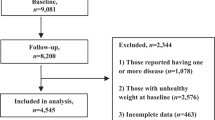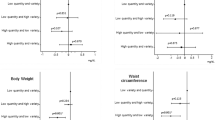Abstract
Background/Objectives:
Globally, fruit and vegetable intakes are well below recommendations despite ample evidence to link insufficient intake with increased risk of overweight and obesity. Intakes of fruits and vegetables in the general population differ between males and females, and although there is growing evidence of intakes in men and women during weight loss, evidence that directly compares intakes in men and women during weight loss is lacking. This study aimed to identify any differences between males and females in fruit and vegetable intakes and plasma carotenoid concentrations during weight loss, and determine whether there is a relationship between any changes in fruit and vegetable intakes and weight change in both males and females.
Subjects/Methods:
Men and women (n=100; body mass index 25–40 kg/m2) aged 18–60 years were selected for the study. Dietary intake of fruits and vegetables was assessed using the Australian Eating Survey and fasting blood was collected to assess plasma carotenoids, which were determined by high-performance liquid chromatography.
Results:
There was little change in fruit or vegetable intakes during weight loss, although men tended to increase fruit intakes. Changes in intakes were influenced by baseline intakes, with males and females with the highest intakes at baseline reducing intakes. Males had better correlations between fruit and vegetable intakes and plasma carotenoid concentrations than females, and fruit and vegetable intakes during weight loss appear to predict weight loss for males but not females.
Conclusions:
Fruit and vegetable intake during weight loss does not appear to differ largely between males and females.
This is a preview of subscription content, access via your institution
Access options
Subscribe to this journal
Receive 12 print issues and online access
$259.00 per year
only $21.58 per issue
Buy this article
- Purchase on Springer Link
- Instant access to full article PDF
Prices may be subject to local taxes which are calculated during checkout
Similar content being viewed by others
References
World Obesity Federation. Trends in prevalence of morbid obesity in adults in Australia, England and USA 2010. Available from: http://www.worldobesity.org/site_media/library/resource_images/Trends_in_morbid_obesity_adults.pdf. Accessed May 2014.
Ng M, Fleming T, Robinson M, Thomson B, Graetz N, Margono C et al. Global, regional, and national prevalence of overweight and obesity in children and adults during 1980–2013: a systematic analysis for the Global Burden of Disease Study 2013. Lancet 2014; 384: 766–781.
Joint WHO/FAO Expert Consultation Diet, Nutrition and the Prevention of Chronic Diseases. WHO: : Geneva, 2003.
Australian Bureau of Statistics Australian Health Survey: Nutrition First Results — Foods and Nutrients, 2011–12. ABS: Canberra, 2014.
Centers for Disease Control and Prevention. State Indicator Report on Fruits and Vegetable. Available from: http://www.fruitsandveggiesmatter.gov/indicatorreport/: CDC, 2009.
Blanck HM, Gillespie C, Kimmons JE, Seymour JD, Serdula MK . Trends in fruit and vegetable consumption among U.S. men and women, 1994–2005. Prev Chronic Dis 2008; 5: 15.
Organisation for Economic Co-operation and Development. Fruit and vegetable consumption among adults 2013. Available from: http://www.oecd-ilibrary.org/sites/health_glance-2013-en/02/08/index.html?itemId=/content/chapter/health_glance-2013-22-en Accessed May 2014.
Charlton K, Kowal P, Soriano MM, Williams S, Banks E, Vo K et al. Fruit and vegetable intake and body mass index in a large sample of middle-aged Australian men and women. Nutrients 2014; 6: 2305–2319.
Freedman MR, King J, Kennedy E . Executive summary. Obes Res 2001; 9: 1S–5S.
Kaiser KA, Brown AW, Bohan Brown MM, Shikany JM, Mattes RD, Allison DB . Increased fruit and vegetable intake has no discernible effect on weight loss: a systematic review and meta-analysis. Am J Clin Nutr 2014; 100: 567–576.
Tapsell LC, Batterham MJ, Thorne RL, O'Shea JE, Grafenauer SJ, Probst YC . Weight loss effects from vegetable intake: a 12-month randomised controlled trial. Eur J Clin Nutr 2014; 68: 778–785.
Rolls BJ, Roe LS, Beach AM, Kris‐Etherton PM . Provision of foods differing in energy density affects long‐term weight loss. Obes Res 2005; 13: 1052–1060.
Mytton OT, Nnoaham K, Eyles H, Scarborough P, Mhurchu CN . Systematic review and meta-analysis of the effect of increased vegetable and fruit consumption on body weight and energy intake. BMC Public Health 2014; 14: 886.
Tapsell LC, Dunning A, Warensjo E, Lyons-Wall P, Dehlsen K . Effects of vegetable consumption on weight loss: a review of the evidence with implications for design of randomized controlled trials. Crit Rev Food Sci Nutr 2014; 54: 1529–1538.
Hebert JR, Ma Y, Clemow L, Ockene IS, Saperia G, Stanek EJ et al. Gender differences in social desirability and social approval bias in dietary self-report. Am J Epidemiol 1997; 146: 1046–1055.
Collins CE, Morgan PJ, Jones P, Fletcher K, Martin J, Aguiar EJ et al. Evaluation of a commercial web-based weight loss and weight loss maintenance program in overweight and obese adults: a randomized controlled trial. BMC Public Health 2010; 10: 669.
Collins CE, Boggess MM, Watson JF, Guest M, Duncanson K, Pezdirc K et al. Reproducibility and comparative validity of a food frequency questionnaire for Australian adults. Clin Nutr 2014; 33: 906–914.
Burrows TL, Hutchesson MJ, Rollo ME, Boggess MM, Guest M, Collins CE . Fruit and vegetable intake assessed by food frequency questionnaire and plasma carotenoids: a validation study in adults. Nutrients 2015; 7: 3240–3251.
National Health and Medical Research Council Australian Dietary Guidelines. NHMRC: : Canberra, 2013.
Lhakhang P, Godinho C, Knoll N, Schwarzer R . A brief intervention increases fruit and vegetable intake. A comparison of two intervention sequences. Appetite 2014; 82: 103–110.
Collins CE, Morgan PJ, Warren JM, Lubans DR, Callister R . Men participating in a weight-loss intervention are able to implement key dietary messages, but not those relating to vegetables or alcohol: the Self-Help, Exercise and Diet using Internet Technology (SHED-IT) study. Public Health Nutr 2011; 14: 168–175.
Al-Delaimy WK, Ferrari P, Slimani N, Pala V, Johansson I, Nilsson S et al. Plasma carotenoids as biomarkers of intake of fruits and vegetables: individual-level correlations in the European Prospective Investigation into Cancer and Nutrition (EPIC). Eur J Clin Nutr 2005; 59: 1387–1396.
Mattisson I, Wirfält E, Aronsson CA, Wallström P, Sonestedt E, Gullberg B et al. Misreporting of energy: prevalence, characteristics of misreporters and influence on observed risk estimates in the Malmö Diet and Cancer cohort. Br J Nutr 2005; 94: 832–842.
Mendez MA, Wynter S, Wilks R, Forrester T . Under- and overreporting of energy is related to obesity, lifestyle factors and food group intakes in Jamaican adults. Public Health Nutr 2004; 7: 9–19.
National Institutes of Health Vitamin A: Fact Sheet for Health Professionals. Office of Dietery Supplements, National Institutes of Health: Bethesda, MD, USA, 2013.
Broekmans WM, Klöpping-Ketelaars IA, Schuurman CR, Verhagen H, van den Berg H, Kok FJ et al. Fruits and vegetables increase plasma carotenoids and vitamins and decrease homocysteine in humans. J Nutr 2000; 130: 1578–1583.
Brown MJ, Ferruzzi MG, Nguyen ML, Cooper DA, Eldridge AL, Schwartz SJ et al. Carotenoid bioavailability is higher from salads ingested with full-fat than with fat-reduced salad dressings as measured with electrochemical detection. Am J Clin Nutr 2004; 80: 396–403.
Wang X, Ouyang Y, Liu J, Zhu M, Zhao G, Bao W et al. Fruit and vegetable consumption and mortality from all causes, cardiovascular disease, and cancer: systematic review and dose-response meta-analysis of prospective cohort studies. BMJ 2014; 349: g4490.
Acknowledgements
RLW is a PhD candidate in Human Physiology at the University of Newcastle, Australia, and is a current recipient of an Australian Postgraduate Award scholarship.
Author information
Authors and Affiliations
Corresponding author
Ethics declarations
Competing interests
The authors declare no conflict of interest.
Rights and permissions
About this article
Cite this article
Williams, R., Wood, L., Collins, C. et al. Comparison of fruit and vegetable intakes during weight loss in males and females. Eur J Clin Nutr 70, 28–34 (2016). https://doi.org/10.1038/ejcn.2015.123
Received:
Revised:
Accepted:
Published:
Issue Date:
DOI: https://doi.org/10.1038/ejcn.2015.123
This article is cited by
-
Fruit and vegetable consumption in relation to primary headaches: the MEPHASOUS study
Eating and Weight Disorders - Studies on Anorexia, Bulimia and Obesity (2021)



